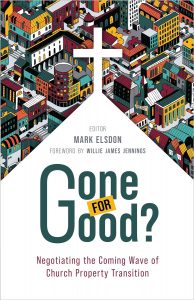Congregations facing closure or downsizing must think about more than maximizing profits from the sale of facilities and other assets, social entrepreneur and church finance expert Mark Elsdon said.
“The principle here is that we have been entrusted as stewards with these assets, these properties and this money,” said Elsdon, editor of Gone for Good? Negotiating the Coming Wave of Church Property Transition.
“Hopefully, we have used these gifts for the good of others during the time we had them, but none of them are ultimately ours and the idea that we should seek the maximum simply because we own them is fundamentally flawed.”
 Guiding congregations through the economic, moral and spiritual dimensions of church closers is the purpose of Gone for Good, he said. The book presents more than a dozen chapters written by real estate professionals, philanthropists and urban planners experienced in helping faith groups navigate a post-Christian secular culture.
Guiding congregations through the economic, moral and spiritual dimensions of church closers is the purpose of Gone for Good, he said. The book presents more than a dozen chapters written by real estate professionals, philanthropists and urban planners experienced in helping faith groups navigate a post-Christian secular culture.
“Each one is doing meaningful work on the ground on this issue. These people are practitioners who ae spending more energy in this work than promoting themselves,” said Elsdon, a Presbyterian Church (USA) minister based in Madison, Wis.
Providing congregations with the resources and wherewithal to prevent or negotiate financial crises is a passion and a calling, he added.
Elsdon combined a master of divinity degree from Princeton Theological Seminary with an MBA from the University of Wisconsin School of Business to co-found Rooted Good, a faith-based nonprofit that equips leaders with the economic development and theological tools needed to make good decisions in a chaotic social environment.
“I guess you could say I’m a social entrepreneur and a nonprofit entrepreneur. My calling is to be at the intersection of money and meaning,” said Elsdon, who also authored We Aren’t Broke: Uncovering Hidden Resources for Mission and Ministry.
The intended audience for Gone for Good includes congregational and denominational leaders and other decision makers around church property. But civic leaders, municipalities, urban planners and anyone else who has influence or concern about the social infrastructure in the nation’s cities also would benefit from the book, Elsdon said, because both generally lack an understanding of the depth and breadth of church-closure trends and how detrimental they can be to congregations and the communities left behind.
 “There are a variety of stats out there, but somewhere between 4,000 and 6,000 churches are closing every year,” he noted. “But no one is tracking it in any systematic way, so there is a lack of understanding about this tsunami of change, this dynamic and the fact there are going to be a lot less churches and a lot more real estate for conversion or development.”
“There are a variety of stats out there, but somewhere between 4,000 and 6,000 churches are closing every year,” he noted. “But no one is tracking it in any systematic way, so there is a lack of understanding about this tsunami of change, this dynamic and the fact there are going to be a lot less churches and a lot more real estate for conversion or development.”
As a result, congregations facing major property decisions rarely have best practices to follow, historian and sociologist Eileen Lindner writes in her chapter, “Church Property in a Diminishing Religious Footprint.”
“The enormous real estate holdings of American churches have great potential for shaping the nation and culture in which we live. Many congregations offer vital ministries to their own members and to adjacent communities. At the same time, a growing number of church properties are underutilized, unoccupied and deteriorating,” Lindner writes.
“Few concerted, cohesive approaches to addressing this shrinking real estate footprint exist, despite the very real value of these properties within the aspirational and financial lives of American religious bodies.”
Contributing author Rochelle Stackhouse says churches facing closure or considering downsizing should filter all offers and decisions through their calling as communities of faith.
“A first step toward a mission-centered building transition, then, is clarifying how the building fits into the congregation’s understanding of their purpose,” Stackhouse, senior director of programs for Partners for Sacred Places, writes in her chapter, “Saving Sacred Places as Community Assets.”
“The hope is that congregations will take on the challenge of making plans for their buildings’ future before it is too late to shape those plans to leave a legacy befitting the mission of the congregations who worshiped and served the community for many years.”
Elsdon added that some congregations choose to ignore financial and demographic realities by refusing to sell. “It’s amazing how long churches will hang on. They certainly hang on longer than a business would in this situation.”
“It’s amazing how long churches will hang on. They certainly hang on longer than a business would in this situation.”
The reasons for that are understandable and the behavior is predictable because members have treasured memories of weddings, baptisms, funerals and other milestones celebrated in those spaces, he said. “Are we wanting to hold onto what’s beautiful about church? Absolutely. But if we are resisting the social change that led us here, that’s a lost cause, in my mind.”
Faith communities resisting closure do so with an image of how church used to be, Elsdon added. “People still want community and a God connection, but it’s not happening on the scale it was on Sunday mornings, and so the space we have for that isn’t working anymore.”
His hope is that Gone for Good will spark collaboration between faith leaders, real estate professionals, urban planners and municipal officials in how church properties are sold and used into the future.
“We need to build capacity and share knowledge between churches and developers around the actions that need to be taken developing these properties,” he said. “We all need to work together on this.”
Related articles:
Before you make church property decisions, consider your mission and calling
7 dos and don’ts when considering the redevelopment of church property | Opinion by Rick Reinhard
Property sale positions Atlanta church to engage its vibrant neighborhood
Church building for sale but congregation’s mission continues
Hospitality on the corner: Gaston Christian Center


